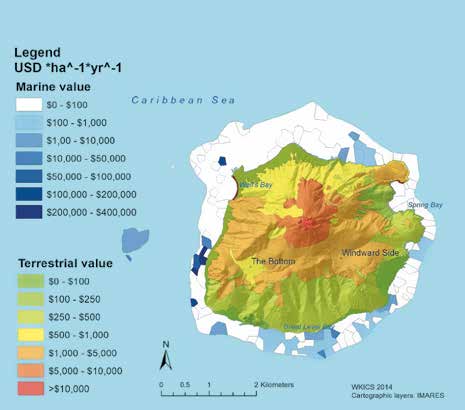This article originally appeared in The Circle 02.15.
Valuing of ecosystem services draws attention to the economic benefits of biodiversity and highlights the growing costs of biodiversity loss and ecosystem degradation. The Arctic, for example, represents a tremendous wealth in natural resources and provides immense ecosystem services, such as unique biodiversity, culture, tourism, shipping and climate regulation. By valuing these ecosystem services, Esther Wolfs says one can create insight into their economic value. This allows, for example, assessing the possible negative impact that oil and gas extraction efforts may have on the economic value of these ecosystem services and biodiversity.
Ecosystem service valuation research addresses the relevant ecosystems, ecosystem services and their beneficiaries in a defined area and applies a range of economic valuation and evaluation tools. It is extremely important for stakeholders to participate, by providing local information and valuable insights and creating public support for the concept of ecosystem services among target audiences.
Research areas could include: the socio-economic value of the Arctic’s ecosystem services using an ecosystem valuation framework; how environment-degrading economic activities in the Arctic affect economic values; what trade-offs can be identified; and how these trade-offs can be managed to optimize the long-term economic benefits of the Arctic’s ecosystem services.
In our research we use the classification of ecosystem services from The Economics of Ecosystems & Biodiversity (TEEB) as defined in their 2008 interim report derived from the Millennium Ecosystem Assessment (MA, 2005):
- Provisioning services (products obtained from ecosystems, such as food and building materials).
- Regulating services (benefits obtained from regulation of ecosystem processes, such as erosion control and storm protection).
- Cultural services (non-material benefits obtained from ecosystems, such as spiritual and religious values and recreation and ecotourism).
- Habitat (nursery service and gene pool protection).
Essential for the valuation of these ecosystem services is to find ways to measure benefits, which do not enter markets and, as such, have no directly observable monetary benefits. Therefore, different methods have been developed to assign a value to non-marketable ecosystem services, such as Contingent Modeling, where one establishes a willingness to pay by stakeholders for environmental services. The approach is to value nature using different market and non-market valuation methods depending on the use or non-use values of the relevant ecosystem services. This is done through the perspective of various stakeholders such as local residents, visitors, tourist industry, international citizens and other relevant users or interested parties. By summing up the worth of the range of valued ecosystem services, the annual Total Economic Value of the natural environment is estimated.
It is important to understand that valuing ecosystem services is an instrument and not a goal in itself. The valuation results should be used for developing tools that can be easily applied to raise awareness for nature conservation, support decision-making on the economic benefits of investing in nature, develop sustainable financing mechanisms to raise funds for nature conservation, serve as input for spatial planning or assess economic loss if natural assets are damaged by, for example, oil spills. These tools can answer questions relating to environmental management issues at stake as identified by stakeholders and local experts. By increasing evidence-based information and transparency on issues that are related to the natural environment more equitable decisions can be made.
One example of such a tool is a value map indicating the most valuable ecosystems in the marine and terrestrial environment of a specific area. By adding up the values for the various ecosystem services, these maps combined form the Total Economic Value (TEV) maps.

Saba – estimated economic value
Insight into the value of different areas for different beneficiaries of ecosystem services can be very useful for spatial planning purposes. First, natural areas with higher values are more important to conserve. Second, different uses of ecosystem services might be in conflict with each other. For example, having fishermen and tour operators in the same area can cause friction that is more easily resolved by identification of the important parts of the marine environment for them. Third, the value maps can be combined with spatial information on environmental threats. Spatial analysis of threats and benefits enable conservationists with limited budgets to prioritize their efforts: areas with high values and high threat levels deserve the most urgent attention. It can also inform government priorities. The government of Saba decided to investigate whether it can extend the boundaries of its terrestrial park based on the Saba value map.
Benefits of TEEB Caribbean Netherlands (PDF)
Esther Wolfs is the founder and director of Wolfs Company which works to show clients the contribution of, and often intrinsically crucial dependence on natural capital.
